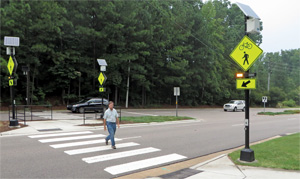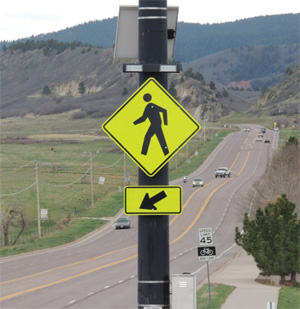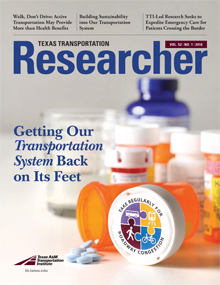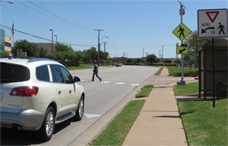For many pedestrians, crossing a busy multilane roadway without the protection of a traffic signal is a nerve-wracking, sometimes dangerous proposition, even when using a marked crosswalk.

As a means of improving safety at uncontrolled pedestrian crosswalks, the Federal Highway Administration (FHWA) has sponsored research on a variety of traffic control devices intended to increase driver awareness and improve drivers’ yielding to pedestrians. One of the devices, the rectangular rapid-flashing beacon (RRFB), has shown positive results — an increase in the number of drivers yielding to pedestrians.
“The RRFB is very effective,” says Kay Fitzpatrick, manager for the Texas A&M Transportation Institute’s (TTI’s) Roadway Design Program. “A study conducted about 10 years ago found that you had to have a device that showed a red indication for drivers to yield at a high enough rate to be considered acceptable. Now with the RRFB, there is a device with a yellow indication where drivers are yielding at much higher rates. Having this device only active when a pedestrian is present is an obvious contribution to its effectiveness. We want to understand what, if any, other characteristics are contributing to the effectiveness.”
“Several agencies are interested in having the RRFB added to the Manual on Uniform Traffic Control Devices [MUTCD],” Fitzpatrick explains. Before adding this device to the MUTCD, however, refinements to its characteristics were needed. An FHWA project conducted by TTI started with a closed-course study conducted at the Texas A&M University Riverside Campus that examined driver detection of a cutout pedestrian photograph in the presence of light-emitting diodes with various brightness levels, flash patterns and locations within the sign assembly. The results from the closed-course study indicated that the flash pattern and the beacon location justified additional investigations on the open road.
The research team used a staged pedestrian approach to evaluate drivers’ yielding on the open road. Under this protocol, a member of the research team acts as a pedestrian using the crosswalk to stage the conditions under which driver yielding would be observed.
The TTI team developed a temporary light bar and controller that permitted the research team to have control over the flash pattern and brightness. Three flashing light patterns were selected for use with the temporary light bars — the pattern currently being used with other installations along with two patterns developed by TTI in collaboration with FHWA and other transportation professionals.

The overall average driver yielding for each of the three flash patterns was between 78 and 80 percent for the eight sites in the study. The statistical evaluation found no difference in effectiveness between the three patterns. Because the tested flash patterns had similar driver yielding results, FHWA issued an official interpretation that favors one of the new patterns (called WW+S) because it has a greater percentage of dark time when both beacons of the RRFB are off (a benefit identified in the closed course) and because the beacons are on for less total time (resulting in energy savings).
“FHWA also wanted to investigate on the open road whether drivers would continue to yield at the same rates if the beacon placement was different,” says Fitzpatrick. “We identified 13 test sites where the communities worked with us and moved the beacons from below to above the sign. That way we had similar drivers and site characteristics when we collected data for both conditions — when the beacons were above the sign and when the beacons were below the sign.”
The findings showed only minor, if any, differences between the above and below positions (the average daytime yielding for staged pedestrians was 64 percent for above and 61 percent for below), and the statistical test showed no noteworthy difference. With the open-road study finding that driver yielding is the same whether the beacons are above or below the sign, and with the closed-course study revealing there are benefits to having it above the sign, FHWA is planning to issue an official interpretation that will allow agencies to place the beacon above the sign.
“The findings from these FHWA studies are helping to refine the device characteristics, resulting in a pedestrian treatment being considered for the next edition of the MUTCD,” says Fitzpatrick. “More importantly, the device is being used in more locations, and drivers are noticing the rapid-flashing yellow beacons and yielding to pedestrians crossing the roadway.”

